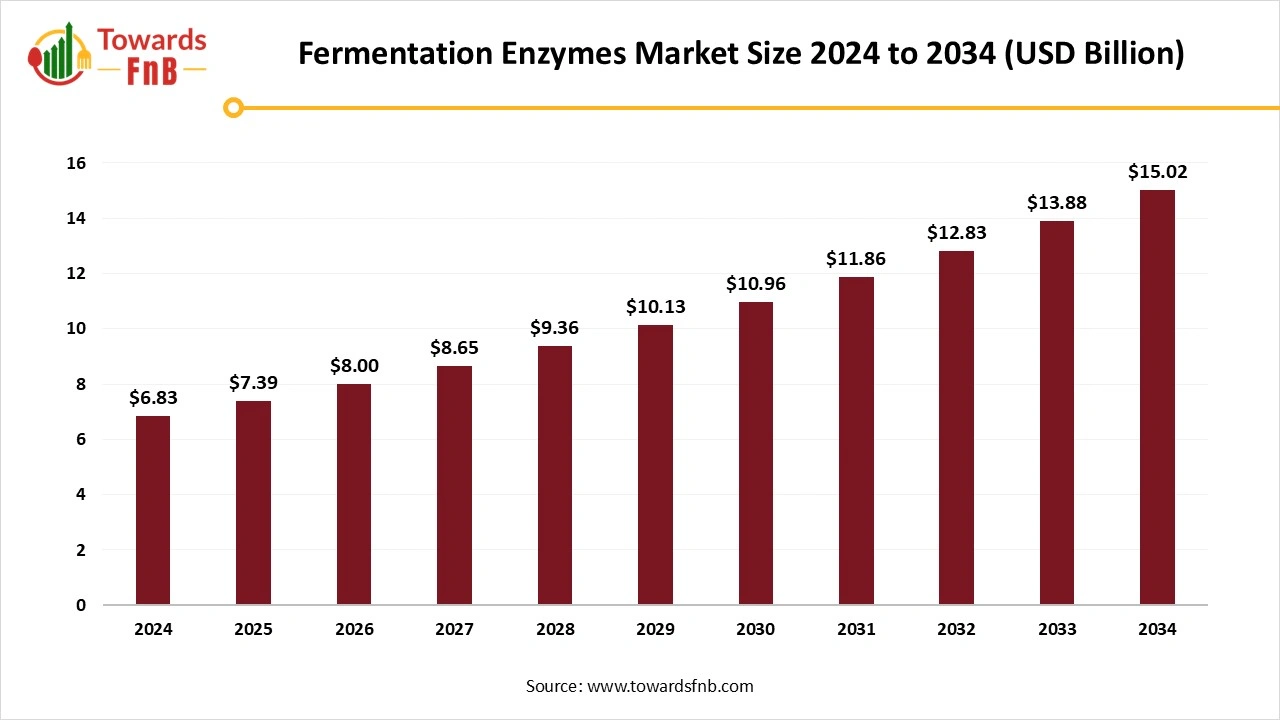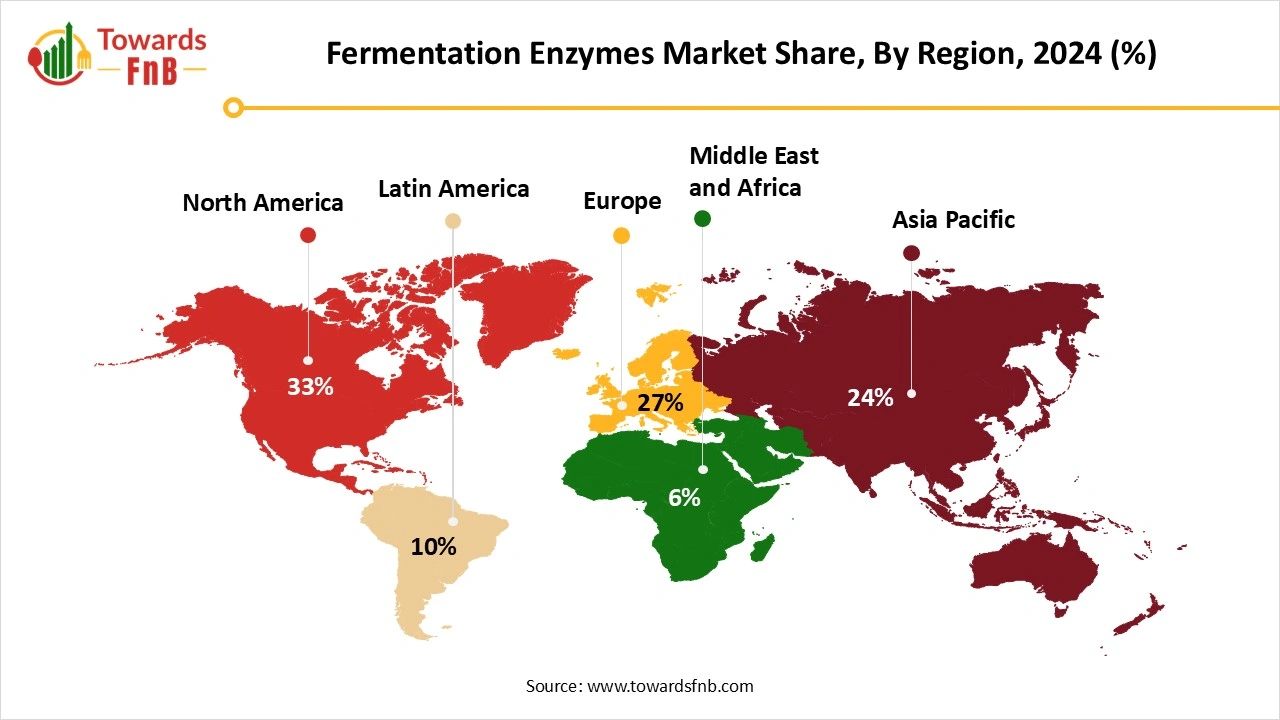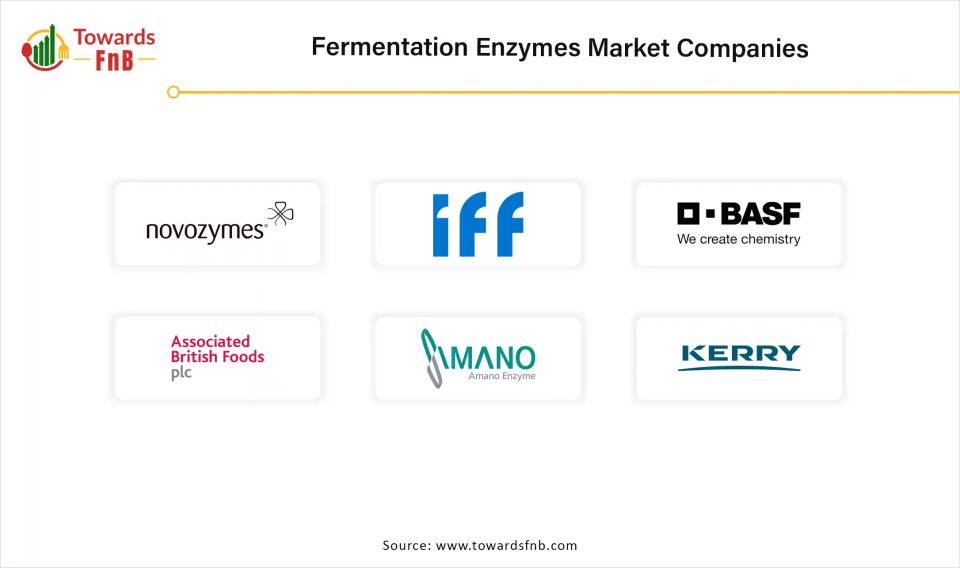November 2025
The global fermentation enzymes market size estimated at USD 6.83 billion in 2024 and is predicted to increase from USD 7.39 billion in 2025 to nearly reaching USD 15.02 billion by 2034, growing at a CAGR of 8.2% during the forecast period from 2025 to 2034. Growing food & beverages sector coupled with growing demand for the clan-label products significantly expanding the market.

| Study Coverage | Details |
| Growth Rate from 2025 to 2034 | CAGR of 8.2% |
| Market Size in 2025 | USD 7.39 Billion |
| Market Size in 2026 | USD 8 Billion |
| Market Size by 2034 | USD 15.02 Billion |
| Largest Market | North America |
| Base Year | 2024 |
| Forecast Period | 2025 to 2034 |
| Regions Covered | North America, Europe, Asia-Pacific, Latin America, and Middle East & Africa |
The fermentation enzymes market comprises enzymes produced through microbial fermentation (using bacteria, fungi, or yeast) that catalyze biochemical reactions essential in the manufacturing of a variety of end-products. These enzymes are integral to industries such as food & beverage, biofuels, pharmaceuticals, and animal feed, aiding in processes like starch breakdown, alcohol fermentation, flavor development, and drug synthesis. The demand for fermentation-derived enzymes is driven by clean-label trends, cost-effectiveness, and their high specificity and efficiency under mild operational conditions.
Recent breakthroughs in fermentation technology have greatly enhanced methods for securing the safety and quality of fermented products. These advancements have revolutionized production techniques, quality assurance procedures, and overall safety measures for fermented products. Recent developments in fermentation enzymes aim to improve the efficiency, sustainability, and flexibility of fermentation methods in different industries. These innovations encompass precise fermentation methods, the use of synthetic biology and protein design, along with enhanced enzyme stability and functionality. Precision fermentation, an innovative biotech technique, enables the creation of tailor-made enzymes with specific functions.
A major constraint is the elevated expense of enzyme production, which may hinder their use in industries that are sensitive to price. The necessity for enhanced infrastructure, specialized tools, and strict regulatory adherence contributes to the total production expenses. Increasing enzyme production to satisfy industrial needs can be costly because of the requirement for specialized machinery and regulated settings. These elevated expenses may restrict the broad implementation of enzymes, particularly in applications where cost is a crucial factor.
North America Dominated the Fermentation Enzymes Market in 2024.
A major factor contributing to growth is the rising demand for enzymes used in biofuel production. With North America speeding up its transition to renewable energy, enzymes are key in improving biofuel production efficiency, presenting a lucrative investment opportunity. With sectors such as pharmaceuticals, agriculture, and biofuels adopting more sustainable methods, the need for industrial enzymes is increasing. Enzymes facilitate more efficient production with reduced energy use and fewer waste products. They are essential in producing bio-based chemicals, providing an eco-friendly substitute for traditional petrochemical methods.

The growth of the market in United States is mainly fueled by advancements in enzyme technologies. Rising demand for enzyme-based solutions in sectors like food and drinks, biofuels, agriculture, and pharmaceuticals is expected to drive demand forward. Advancements in sustainable and bio-based products are aiding companies in fulfilling consumer preferences for clean-label and natural ingredients, thus increasing demand. Continuous advancements in biotechnological techniques are improving enzyme production, providing more efficient and affordable solutions. Rising awareness of the health advantages of fermented products is driving market expansion, especially in the food and beverage sector. As sectors transition to more sustainable and eco-friendly options, enzymes offer a green substitute for chemical methods.
Asia Pacific Expects the Significant Growth During the Forecast Period.
The fermentation enzymes market is propelled by rapid industrial growth in the Asia Pacific region. The expanding industrial foundation in the region, especially in nations like China and India, drives the need for fermentation chemicals in multiple industries, such as biofuels, pharmaceuticals, and food and beverages. Industrial development results in enhanced production capabilities and the implementation of cutting-edge fermentation techniques. With the growth and modernization of industries, the demand for fermentation chemicals to aid various applications keeps increasing. Increasing Demand for Processed Foods: The rising demand for processed foods in the Asia Pacific area greatly influences the market. Growing incomes, urban development, and shifting dietary habits lead to higher demand for processed and convenient foods. Fermentation agents are crucial in creating a variety of processed foods, such as snacks, drinks, and dairy items.
The market share of fermentation enzymes in India is growing due to the rising need for bio-based chemicals, the expanding pharmaceutical industry, and greater use in food processing. Moreover, governmental programs that encourage sustainability are fostering innovation and industry acceptance in various sectors. The increasing awareness of health among consumers and significant funding in biotechnology research are fundamentally changing the food manufacturing industry. The increasing need for eco-friendly production methods is allowing the market to expand. Top enzyme producers and biotech companies are progressively adopting advanced fermentation technologies and genetic engineering methods that convert traditional enzyme production into highly efficient, economical manufacturing systems that fulfill stringent industrial needs
How Amylase Segment Dominated the Fermentation Enzymes Market in 2024?
Amylase (carbohydrase) segment led the fermentation enzymes market in 2024. The amylase segment has seen considerable growth in recent years, fueled by the rising need for enzymes across multiple sectors, especially food and beverage, pharmaceuticals, and biofuels. Amylase, an enzyme that facilitates the breakdown of starch into sugars, is essential in the making of bread, beer, and various carbohydrate-laden items. The amylase market is projected to maintain its growth trend, fueled by continuous improvements in fermentation technology, rising demand for processed foods, and broader applications across different sectors.
Lipases Segment is Observed to Grow at the Fastest Rate During the Forecast Period.
Lipases are essential in the dairy and bakery sectors, facilitating processes such as cheese aging, dough improvement, and fat alteration to boost product quality. Moreover, the need for low-fat and functional food items is driving the use of lipase enzymes, which facilitate fat hydrolysis and emulsification. Lipase enzymes are becoming increasingly favored in biodiesel production because of their effectiveness in the transesterification process. Lipase is utilized in various sectors, boosting food taste, assisting in stain removal in cleaning products, and enhancing drug delivery mechanisms in the pharmaceutical field. It is additionally utilized in cosmetics to enhance product stability and efficiency.
What Made Bacterial Fermentation The Dominant Segment In 2024?
Bacterial fermentation segment held the dominating share of the fermentation enzymes market in 2024. The benefits provided by bacterial expression systems, including shorter development times, increased expression levels, and lower media costs compared to mammalian cell cultures, have significantly fueled the renewed interest in employing bacterial organisms in manufacturing processes. In general, microbial fermentation technology provides greater yields, quicker development, improved scalability, decreased variation between batches, and reduced production expenses.
Fungal Fermentation Segment is Seen to Grow at a Notable Rate During the Predicted Timeframe.
Fungi are well-suited for use in fermentation processes because of their natural capacity to thrive on solid organic materials with low moisture levels and their ability to produce various extracellular enzymes. Fungal fermentation is commonly utilized in creating enzymes, organic acids, biofuels, and protein-rich food components and is being increasingly investigated in solid-state systems for sustainable outcomes. Fungal enzymes possess adequate stability to provide produced items with suitable shelf life, reasonable price, and accepted requirements. Fungal enzymes have been utilized since ancient times to the present in various industries, including baking, brewing, cheese production, antibiotic creation, and the manufacturing of goods like linen and leather.
Why did the Baking Segment Dominate in 2024?
Baking segment dominated the market with the largest share in 2024. For centuries, the baking sector has utilized yeasts and enzymes to produce a diverse array of top-quality goods. Enzymes are crucial in baking, offering important advantages from dough formation to prolonging shelf life, thereby improving product quality and uniformity. Enzymes function as biological catalysts; proteases and amylases decompose proteins and starches, altering dough rheology and enhancing fermentation. Lipases and oxidases enhance dough texture by means of emulsification and oxidation, with lipases generating fatty acid derivatives during fermentation, which adds to the flavor and aroma of baked items.
Bioethanol / Biofuels Segment is Expected to Grow at the Fastest Rate in the Fermentation Enzymes Market During the Forecast Period.
Biofuels are increasingly recognized as an effective means to decrease carbon emissions, providing emissions that are almost 60% lower than those from traditional fossil fuels. Enzymes are essential in biofuel production, serving as natural catalysts that decompose complex biomass into fermentable sugars. About 70% of worldwide bioethanol production is dependent on enzyme-driven processes, highlighting their crucial importance in the sector. Increasing worries regarding climate change and the necessity to lower greenhouse gas emissions have prompted a transition to renewable energy options.
Which Form Held the Largest Share of the Fermentation Enzymes Market in 2024?
Liquid enzymes segment held the largest share of the market in 2024. This supremacy is linked to its excellent solubility, simple mixing, and extensive use in fruit juice clarification, winemaking, and textile processing. Liquid formulations are favored in continuous production systems where quick enzyme activity is essential. Liquid formulations are commonly used in the food and beverage sector for purposes such as juice clarification and starch conversion, in addition to being utilized in textiles and detergents to improve cleaning effectiveness.
Dry/Powder Enzymes Segment is Observed to Grow at the Fastest Rate During the Forecast Period.
Due to their reliability, long shelf life, and convenience in handling during storage and transport. Powdered enzymes provide enhanced thermal stability, making them ideal for high-temperature processes in industries like baking, textiles, and detergents. Their capacity to sustain enzymatic activity for extended durations guarantees reliable performance in multiple industrial applications. Moreover, powdered enzymes provide versatile formulation choices, permitting manufacturers to tailor enzyme mixtures based on application requirements
Which End Use Industry Dominated the Fermentation Enzymes Market In 2024?
Food processing segment dominated the market in 2024. The wide variety of packaged foods, like beverages, meat, dairy products, seafood, and poultry is majorly fragmented. Enzymes are often used to aid production when foods are packaged for commercial purposes. Enzymes have greatly changed the way food and drinks are processed, allowing for natural, effective, and sustainable methods. Enzymes enhance the flavor, look, and quality of beverages and food. The rising demand for natural ingredients has resulted in a greater dependence on food enzymes in production. Shoppers are increasingly mindful of their health, pursuing items that meet clean-label criteria.
Pharmaceuticals & Nutraceuticals Segment held the Dominating Share of the Market in 2024.
Consumers are increasingly recognizing the health advantages linked to nutraceuticals and functional foods that include fermented enzymes. A significant factor behind this growth is the industry's economic and sustainable capacity to identify and develop innovative therapies along with biological remedies. A significant factor is the increasing acceptance of enzymes, enzymatic formulations, nutraceuticals, which have enlarged the market size of the entire industry. Fermented enzymes obtained from microbial and animal origins provide specific remedies for different health issues, thereby boosting this expansion.
dsm-firmenich
Novonesis

By Type of Enzyme
By Source of Enzyme Production
By Application
By Form
By End Use Industry
By Region
The global resistant dextrin market size is projected to witness strong growth from USD 0.45 billion in 2025 to USD 0.92 billion by 2034, reflecting a...
The global duck meat market size is rising from USD 3.40 billion in 2025 to USD 5.89 billion by 2034. This projected expansion reflects a compound ann...
The global protein hydrolysate market size is projected to expand from USD 3.76 billion in 2025 to USD 6.27 billion by 2034, growing at a CAGR of 5.85...
The global carbonated beverages market size is expected to register at a CAGR of 6.5%, growing from USD 654.98 million in 2025 to USD 1,154.44 million...
November 2025
November 2025
November 2025
November 2025